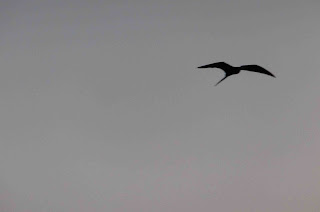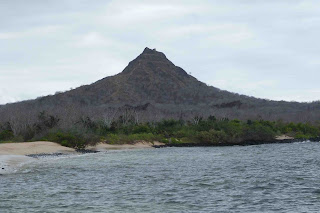Volcanes y Playas - Volcanoes and Beaches
After arrival into the capital city of San Jose, we head to the still active Arenal Volcano, where our biking begins. Following the chain of volcanoes in the country's
north our trails take up through the foothills of the Tenario, Miravalle and Rincon del Viejo Volcanoes, before our transition from a tropical to a dry climate. From here its time to head to the coast and our final four days of biking as we enjoy some wonderful coastal trails from Samara to Coyote.
The riding on the trip is suited to those of a reasonable fitness as there are few difficult sections. With so much to see, this is a well paced trip with plenty of nature opportunities along the way to absorb this most unique of destinations. - Trip Notes: Saddle Skeddadle
In an unpredictable world our flight from Quito to San José Costa Rica went without a hitch.........almost.
January 14th
We went to the airport very early that morning, and good thing we bid because when we stepped up to the counter for our tickets the very pleasant agent asked to see, not only our passports, but also our Yellow Fever Certificate.
"Our what?"
"Your Yellow Fever Certificate, everyone who leaves Ecuador has to have one." We could see she was adamant.
The interesting thing (interesting now that we are home) is that we didn't need the certificate to get into the country, and the vaccine is not even recommended by the World Health Organization for travellers in our circumstances.
Not recommended for travellers whose itineraries are limited to all areas above 2300 meters altitude, the cities of Guayaquil and Quito, and the Galapagos Islands - World Health Organization
"You have to go to the hospital and get a certificate," she said.
"The hospitalI?"
At the mere mention of the word horrid thoughts flooded to mind - a crowded waiting room that would take forever to get through, not begin able to speak Spanish to help ourselves when we got there, getting there, getting back, the plane leaving without us, which hospital and where?
Helpfully, the attendant checked our duffle bags through and printed our tickets.
"These will be waiting for you when you get back. You won't miss your flight. The hospital is fifteen minutes away."
And with that we were off on a mad dash out of the airport to: find a cab, show the driver the address the agent had written down, doubt whilst he tried to figure it out, worry as he was sometimes stuck in traffic, tell him when he got there to wait so that he could drive us back, scramble in the front door of Centro Médico Axxis, Vozandes, 260 y Av. América (fortunately a very helpful woman who spoke English told us exactly where to go), walk in the doctor's office, get jabbed, pay $35.00 USD per person for the vaccination, thank the doctor for filling in (backdating) the certificate, scurry back out of Centro Médico Axxis, Vozandes, 260 y Av. América, jump in the cab, get back to the airport, pay the driver, dash back into the terminal and collect our tickets! We made it!
In the departure lounge we shared a chocolate bar in celebration - just another travel story, full of anxiety, but with a happy ending.
We arrived in San José Costa Rica on time and were met at the airport by John, one of our two cycling guides from Saddle Skeddadle.
We must say that our experience with Saddle Skeddadle was excellent. This is a company that knows its business, and conducts itself very professionally, in other words they are serious both about cycling and client service. This is a happy contrast to Exodus, who in India ran a trip with a cycling leader, who on the first day announced that he did not like cycling - a non-cycling, cycling leader. Go figure! Is it a surprise that, out of the blue, we have bumped into three couples whose experience with Exodus is the same as ours, and will have nothing to do with that company again? Perhaps not.
Jan 15th Warm up Ride to Volcan Arenal & John Speak
Not only is it important to learn the rules of the road wherever you are, it is also important to understand it's language, or more precisely, be able to decode euphemistic speech.
Our first day was described as a warm up ride. Warm indeed, 33°C on "undulating" terrain. "Undulating" is one of the terms that John used frequently. His other expressions included "naughty hills, cheeky hills and rude hills" - interesting personifications, that are best decoded:
- Undulating: convulsing (often paroxysmally)
- Naughty hill: short, quite steep but manageable [syn. Testy]
- Cheeky hill: long, steep, and tough [syn. Ornery]
- Rude hill: Very long, very steep, and painful [syn. Cruel]
- Warm: Volcanically hot
The truth is there were more Ornery and Cruel hills than Testy ones, and all of them were cycled in 'warmth'. After the first day we did not forget our electrolytes again.
At the end of two and a half hours of 'warm up ride' we came to a bridge beneath which a river spilled into a large, rocky basin. What a relief to descend the slippery bank and wade into the cool, clear water. On the opposite side a rope had been attached to a heavy tree limb. Above the sound of rushing water in turbulent pools, a loud yell and splash could be heard as the next Tarzan or Jane swung off the bank and plunged into the beckoning pool. This place was the stuff of storybooks.
Jan 16th Lake Arenal
Breakfast 7h30 on the bikes at 8h30.
If one were to put the next days to a sound track at least some of the lyrics would surely include:
One more mountain to climb,
one more river to cross,
I come such a long long way and still,
I got a long way to go.
Weary all of the time,
I've been tumbled and tossed,
there's always one more mountain to climb
and one more river to cross. (Dr Music - One More Mountain To Climb)
John said that 40% of the ride would be steep (maybe he did not want to be discouraging because it felt like 40% steep, 30% really steep, and all of that (5h30 total) cycled in the heat and on gravel, rock strewn roads. This was one tough day!
There was a welcome sprinkle of rain as our guides set out a picnic lunch on the shore of the lake. Our second guide, Maurice, makes a fantastic guacamole! Everything was good again.
The afternoon ride was on one of the few paved sections we cycled. Pleasant indeed!
Saddle Skeddadle rates this trip Grade 3.
Grade 3- Moderate: Aimed at regular cyclists who have a degree of off road experience. Some moderate and difficult technical sections. Distances of 25-50 miles / 40-80 kms per day.
Grade 4- Challenging: For regular mountain bikers who have a good level of fitness. Routes with frequent moderate to difficult technical sections. Distances of 25-50 miles / 40-80 kms per day.
Of course, one cyclist's 3 is the next one's 4 and vice versa, however many of us agreed that this day was a resounding 4!
Jan 17th River Crossings, Rocky Climbs, Mud Trails and A Bull - One cannot say this trip was without variety!
Up at 6h00, breakfast 7h00, on the bus at 8h30, 45 minute transfer to the starting point. Today was much more pleasant, and cooler.
Back on the bike, Heidie did very, very well. For her it was not just the demands of steep climbs, river crossings and perilous descents, it was the challenge of doing those things with the knowledge that both her elbows had been broken only a year before - the pins and bands visible just beneath the skin. Our son calls her a "Bad ass granny", and she is that. She went down twice during this trip, each time the POC elbow pads that she now always wears when she rides protected the vulnerable joints.
It was quite a day!
There was another sprinkle of rain as our guides set out or second picnic lunch.
The day ended with an indulgent dip in a hot springs and a well-deserved cold beer.
Jan 18th & 19th Big Wind and White Heat
The day began in wind and cloud and comfortable temperatures. There was a long down hill after a long steep climb through a wind farm. It would have been nice not to have had the added challenge of cycling uphill into the wind!
As we got closer to Liberia, John warned us that it was likely going to get hot, as if a switch had been thrown. "White hell" is how he said one cyclist had described it. He was right! 33.5 °C as we approached Guanacaste.
Lunch on the 18th was in typical Costa Rican restaurant, or Soda, where it was casados all around.
(fish, rice, beens, plantain, sweet corn)
Jan 20th Off to the Pacific Coast
Hot, you bet! 36°C in the shade, 41° in the sun, however when we got there, the setting was spectacular!
After all the riding there had to time on the beach
Not a bad place for a picnic lunch!
That night we arrived in Samara where we would have a free day on the 21st.
It is funny to think that at the hotel Giada at Samara beach we would have the finest Italian food we have ever eaten. The hotel owner, who is Italian, is a master chef.
Jan 21st - Free day in Samara,
We greatly appreciated this day off the bike to stroll around this small beach community town, popular with surfers and what looked like old hippies driving around on four wheelers. The place had the atmosphere of a stereotypical California surfer hang-out. You could almost here Beach Boys singing.
'Pioneering' is another one of John's interesting expressions - something that means; "we were not sure how to get there from here."
The three days involved more interesting river crossings, single track, and one occasion riding along side a barbed wire fence.
The evening of the 22nd provided a stunning sunset
Without question the morning beach ride, about 45 min in total (31.5°C at 7h45) was the highlight of the trip.
Our final 3 hours of our cycling brought us to Playa Malpais (aptly named because it means badlands). A bone jarring, potholed, washboarded gravel road leads into town. The air is chocked with thick, blinding dust thrown up by an endless stream of rattling, squeaking vehicles that speed by. A dull grey layer of grit has fallen on everything. It is as if the place is trying to bury itself alive. No Pura Vida here.
This was our first cycling experience with Saddle Skedaddle, and it won't be our last. We cannot say enough about the attentiveness of John and Maurice - exemplary cycling leaders indeed.

































































































